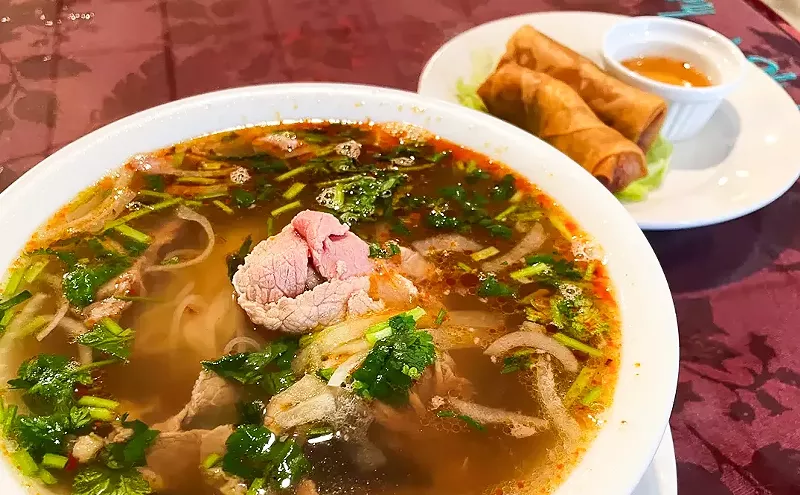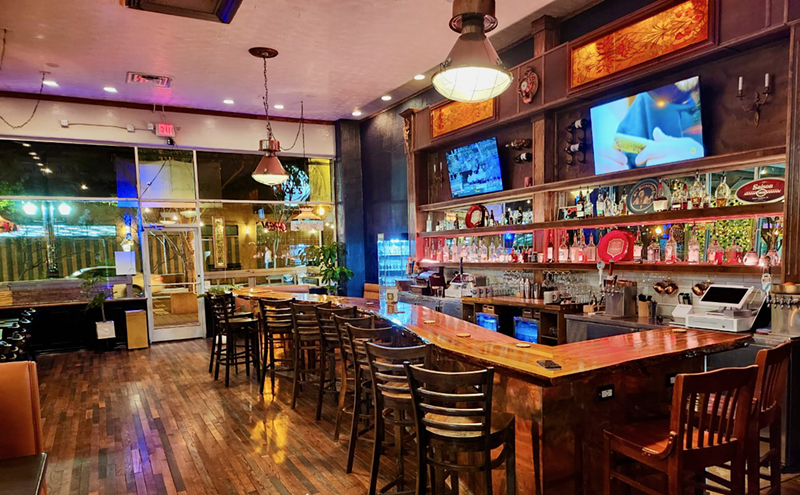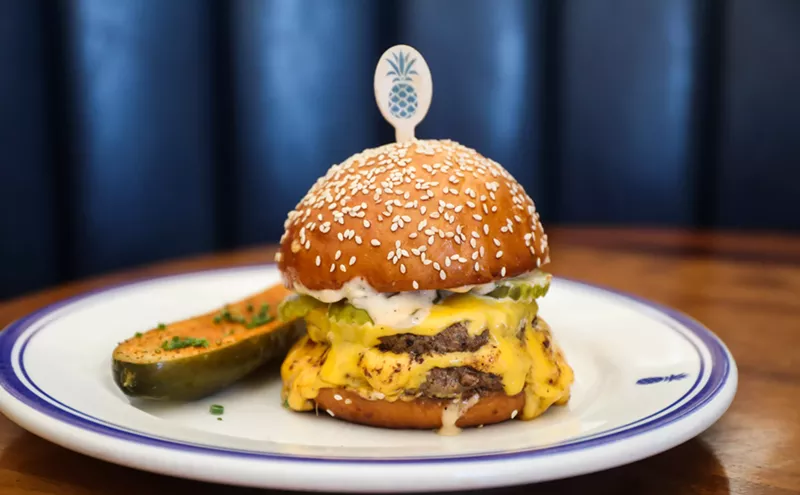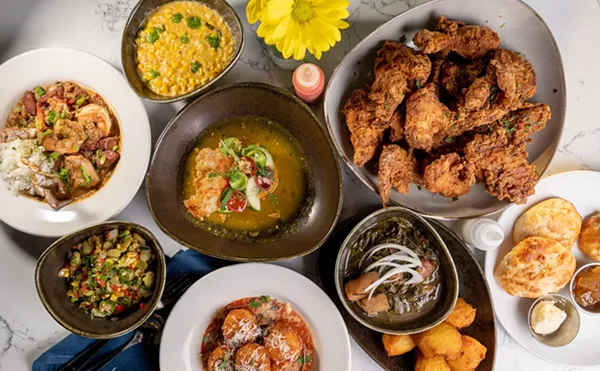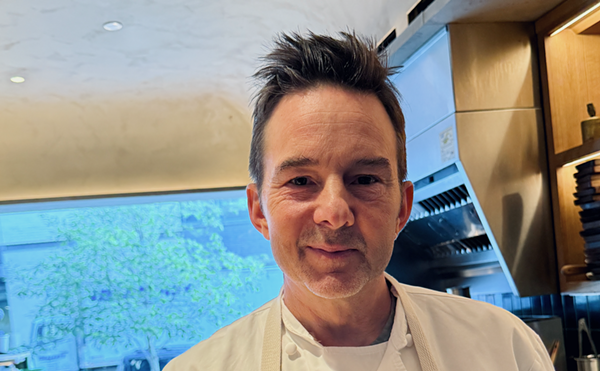A few menus here feature things like flounder cheeks. Monkfish liver is a popular entrant in Japanese cuisine. But it takes a culture of confidence to flaunt the back end of a carp. Our server explained this was a Shanghai delicacy. He appeared nervous when this piqued my interest. He backpedaled.
"Lots of bones," he said, shaking his head in a way that said, "Pinhead, this ain't no cutesy set of flounder cheeks. This is food fraught with sweat and peril."
This wasn't the only time the bone warning came up. It came again when we ordered the smoked fish. "Lots of bones," he repeated. Was Shanghai run by Chinese chefs or trial lawyers? A half-dozen dark glistening sections of fish arrived on a simple white plate. The fish was more sweet than smoky. Smoked fish in the West is generally cured in salt (sometimes with a little wine or vinegar) before it is fumigated with hickory or apple wood or maple or something even more exotic. At Shanghai the fish is sticky and chilled instead of moist and supple; hard and waxy--almost crunchy--instead of flaky. And it is riddled with tiny needles, making it a distressing hazard to chew.
Still, I wanted that carp tail. And when our server returned a few minutes later to tell us the last one had been cooked and served and there was no kitchen spare, I went to the line item just below it: red-cooked buffalo carp, the whole thing. "It has bones, too." This time he smiled.
Like eel and crab, carp is a central component of Shanghai cuisine, which is replete with "river food" because two rivers, the Yangtze and the Huangpu, snake through the metropolis. Shanghai is the vortex of Chinese cuisine, a city that sucks influences from north and south and blends them willy-nilly. Wheat buns, noodles and dumplings, along with rich, oily sauces, echo the north while simple seafood preparations and rice dishes hint at southern cues.
The cuisine is anchored by red cooking, a process by which foods are slow-cooked or braised in a heavy and highly flavored sauce composed of thick soy sauce, ginger, sugar, shaoxing wine (glutinous rice wine) and sometimes cinnamon and star anise.
Red buffalo carp is one of the oddest dishes I have ever seen, odder than even a lobster martini. It looked like separated barbecued ribs strung together at the top with a rope or something. In this case, the rope was the back skin with a section that had a fully intact fin. Long curving sections of fish--strips, really--draped the plate. They glistened in the dark sauce--sweet, but not heavily spiced. The meat was juicy and firm, but the flavor was mossy, maybe a bit monochromatic. And it was full of those sharp bones that scrape at the back of your throat like tabby claws if you don't weed them out before you swallow. Weeding is what draws the sweat.
Shanghai Restaurant is brightly lit, as bright as a surgical theater. Potent floods sluice light from the ceiling, a utilitarian structure of white acoustical tiles. Those tiles slope upward in the center of the room, forming a kind of rectangular dome. Light spills down onto the tables and drenches the red lazy Susans and the white plastic tarps that shield the white tablecloths.
Huge color posters of Shanghai hang from the walls, one featuring The Bund, a tree-lined boulevard that ribbons along the west bank of the Huangpu River.
Shanghai's menu is loaded with the typical--hot and sour soup and spring rolls (cabbage-heavy tubes fried into crispness)--and the atypical, such as sautéed eel and jellyfish. The latter appears with radish slivers, a compelling combination. Jellyfish has almost no flavor, just a crunchy texture that can sometimes mimic rubber or silicone. But here the shreds of opaque jellyfish, mingled with carrot strings and rings of scallion along with the radish, are lightly crisp and splashed with a zesty vinaigrette. This is among the best jellyfish presentations I've come across.
Other things sound blandly typical but appear as interesting oddities on the plate. Paper-thin seasoned beef slices, oval sheets of cold and dark meat that look as if they had been shaved from a loaf with a straight razor, are arranged horizontally across the plate. Liberally framed in dirty white fat globules, the meat is dry and waxy. A bone warning would have been apropos. Lodged in a few of the impossibly thin pieces of meat were bits of beef shrapnel--blunt and dull instead of sharp and piercing.
The bland-sounding-but-interesting reached an apex in a thing called Shanghai-style crab with tofu casserole. It's hard to sex up a dish with tofu and casserole in the title, but like successfully eating a carp, it's possible with effort. The ingredients arrive in a black pot, steeping in a thin broth with a delicately briny flavor. It didn't contain tofu in cube form as is common in miso soup and other Japanese dishes. It was carved into thin, smooth irregular strips, like smashed cheese curds. Instead of shredded, the crab was dismembered, the meat shielded in bits of shell--more bones. No tools to pry open the claws and legs were provided. The body was whole, and under the cavity were clumps of orange, waxy crab roe. This was an exotic treat, the sexed-up part of the dish. It's rare to find female crabs sold commercially, since most commercial shellfishery management strategies discourage harvesting female crabs.
Also served in pieces is the crispy baby chicken, a whole bird with its appendages hacked off and its body carved into slices. Served in a bland light brown sauce, the meat was dry, though the skin was crisp and greaseless.
Wine service at Shanghai is crude, which isn't surprising since the place doesn't have a liquor license and you can drink only what you've brought. Glasses, with a thick gold band around the rim and a gold pinstripe a few millimeters below that, arrived wet and smeared with fingerprints. The server lined up the glasses on the lazy Susan, counted the number of white and red requests, poured the requisite number of each and turned the Susan in front of the diners, inviting them to pick one. This procedure heightens the velocity of the wine-service ritual.
Since Shanghai cuisine is dominated by the red cooking process and its reliance on a heavy, sweet sauce, white wines such as those that work well with spicier Asian cuisines (Riesling, Gewürztraminer) could work, but even heavily oaked California or Australian chardonnays might work (unctuous to unctuous). Reds can stand up, too, since the meat dishes are generally not overly spiced.
Mongolian beef with onions and scallions contained juicy pieces of tender beef in a smooth brown sauce with just a slight spice prick.
Minced fish with pine nuts was another bland collection. A dune of fish, chopped into tiny cubes, was studded with peas, pine nuts and scallions. Thin and faded tomato slices ringed the plate--slices that were just as bland as the center of the plate.
Eight-treasure rice pudding was the Shanghai endgame--a glistening bowl of glutinous rice stained rust in spots by dashes of sweetened red bean paste. This must be an acquired taste, because we couldn't get the Elmer's visuals out of our heads. But at least it didn't have bones.
12817 Preston Road, No. 132, 972-239-1400. Open 11 a.m.-9:30 p.m. Sunday-Thursday and 11 a.m.-10 p.m. Friday & Saturday. $$



